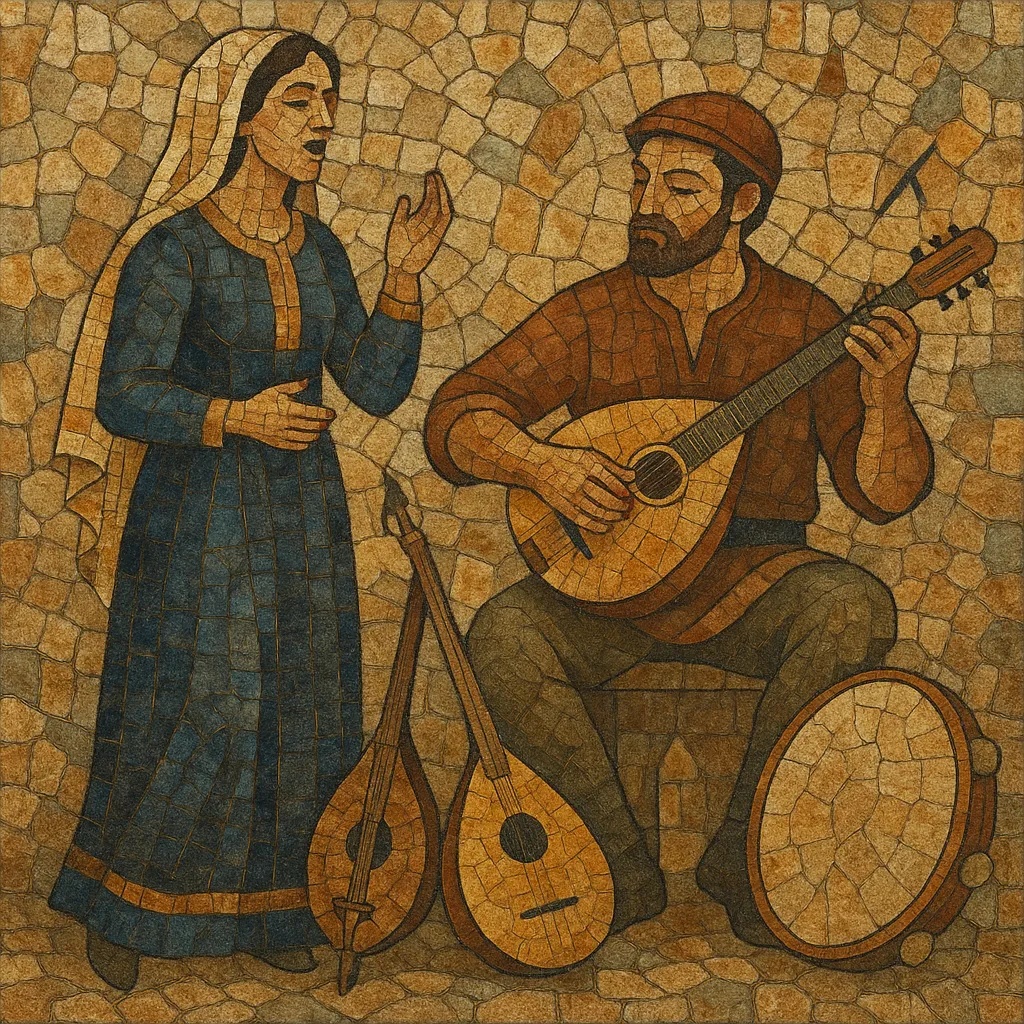Greek folk music (Dimotiká) is the traditional song and dance culture of Greece, shaped by centuries of life in villages, islands, and mountain communities. It is largely modal rather than tonal, drawing on the maqam/echoi systems and favoring melismatic vocals, drones, and expressive ornamentation.
The style is highly regional: Epirus favors slow, austere polyphonic singing and clarinet-led laments; Macedonia and Thrace feature lively gaida (bagpipe) and violin tunes; the Aegean islands and the Dodecanese emphasize lilting syrtos; Crete highlights the bowed lyra, laouto (lute), and improvised mantinades couplets; Pontic music uses the kemenche (lyra) with driving rhythms. Dance metres frequently use asymmetrical patterns such as 7/8, 9/8, and 5/8, accompanying forms like syrtos, kalamatianos, tsamiko, and hasapiko.
Typical instruments include the klarino (clarinet), violin, laouto, Cretan or Pontic lyra, santouri (hammered dulcimer), kanonaki (psaltery), gaida, zournas (shawm), daouli (double-headed drum), and defi (frame drum). Themes cover love, migration, seafaring, klephtic (brigand/heroic) traditions, seasonal rituals, and historical memory.
Greek folk music grew from communal song and dance practices stretching back to Byzantine and earlier times. Church traditions (Byzantine chant/echoi) and the broader maqāmic world of the Eastern Mediterranean provided the modal language, while village ritual, seasonal cycles, and dance shaped forms and performance contexts.
Under Ottoman influence, instruments like zournas, gaida, and later clarinet became central in many regions. Distinct local idioms crystallized: Epirus’s polyphonic singing, island syrtoi, Cretan lyra repertories, and Pontic kemenche styles. Songs circulated via fairs, weddings, and traveling musicians, blending Greek, Balkan, and Anatolian elements.
Following independence, collectors and philologists began documenting “dimotiká” as pillars of national identity. Printing, urban markets, and the first recordings (early 20th century) disseminated regional tunes beyond their home areas. Clarinet-led ensembles became emblematic in mainland festivities, while island repertoires spread through merchant and migrant networks.
Shellac and vinyl recordings fixed canonical versions of dances like kalamatianos, tsamiko, syrtos, and hasapiko. Urban genres such as rebetiko and later laïko drew heavily on folk melodies, rhythms, and modal vocabulary. Radio and state ensembles promoted a standardized image of the tradition while sustaining regional variation.
From the 1970s, collectors and artists (e.g., Domna Samiou) led revivals that emphasized authenticity and regional nuance. Contemporary performers fuse folk with classical, jazz, and global traditions, while festivals and dance associations keep local styles vibrant. Diaspora communities help maintain and evolve the tradition abroad, and field recordings, archives, and educational programs continue to expand access and scholarship.
Use combinations of klarino (clarinet), violin, laouto (lute), Cretan/Pontic lyra, santouri (hammered dulcimer), kanonaki, gaida (bagpipe), zournas (shawm), daouli (double-headed drum), and defi (frame drum). Choose instruments according to region (e.g., lyra & laouto for Crete; clarinet & violin for mainland; gaida/zournas for Thrace/Macedonia).
Compose melodically in modal frameworks related to maqam/echoi (e.g., Hijaz, Ussak, Rast, Nikriz). Favor stepwise motion with cadential tones and emphasized scale degrees. Employ melismas, mordents, slides, and microtonal inflections; sustain drones (ison-like) or pedal notes under vocal lines for a traditional feel.
Adopt asymmetric metres: 7/8 (often 3+2+2), 9/8 (2+2+2+3 or 2+2+3+2), 5/8, and also simple 2/4 or 3/4 when appropriate. Match metre to dance/function: kalamatianos (7/8), syrtos (2/4 or flowing 4/4), tsamiko (majestic, often 3/4 feel), zeibekiko (9/8, free/solo urban dance). Keep percussion patterns supportive and cyclic, spotlighting the dance pulse.
Use strophic forms with repeating melodies over quatrains or couplets; allow instrumental taximia (improvised preludes) to set the mode. Harmony is sparse—emphasize modal drones and open fifths rather than functional progressions. Arrange heterophonically: multiple instruments ornament the same tune with slight variations.
Write lyrics about love, exile, seafaring, seasonal/ritual life, and klephtic heroism. For Cretan styles, craft mantinades (15-syllable couplets) with vivid imagery. Vocal delivery should be expressive and ornamented; in Epirus-inspired pieces, include sustained drones or polyphonic parts (lead, drone/isokrates, and answering voices).
Prioritize live interplay and dynamic rubato in introductions (taxim). Use regional timbres (e.g., bright clarinet, resonant laouto strums). Record in spaces that capture natural ambience; minimal processing preserves authenticity. Keep arrangements dance-oriented and allow room for instrumental breaks and call-and-response.


